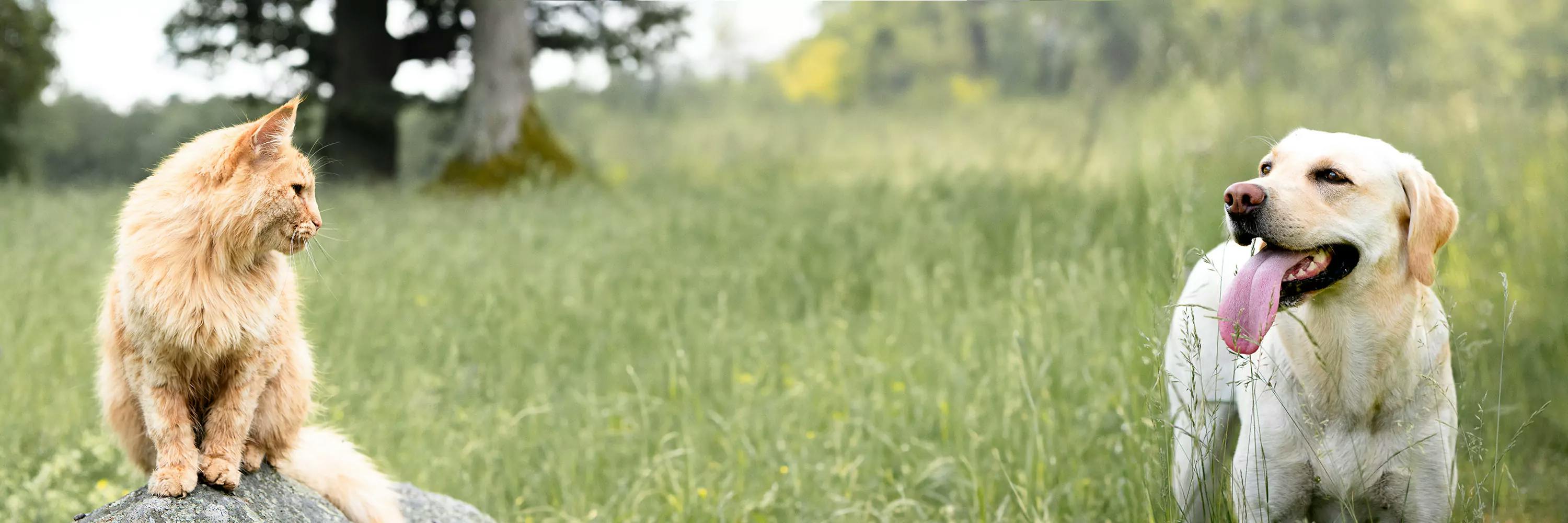Active location:
Select your country:
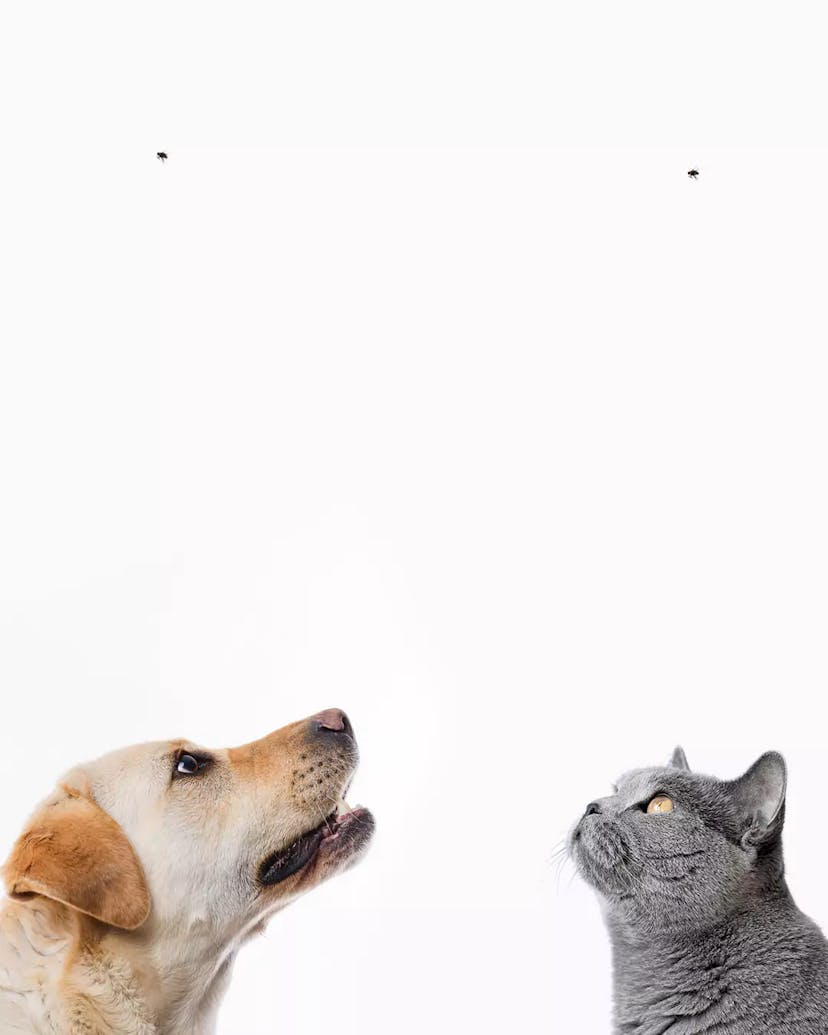
Why insects?
Unbeatable nutrition - sustainability as a bonus!
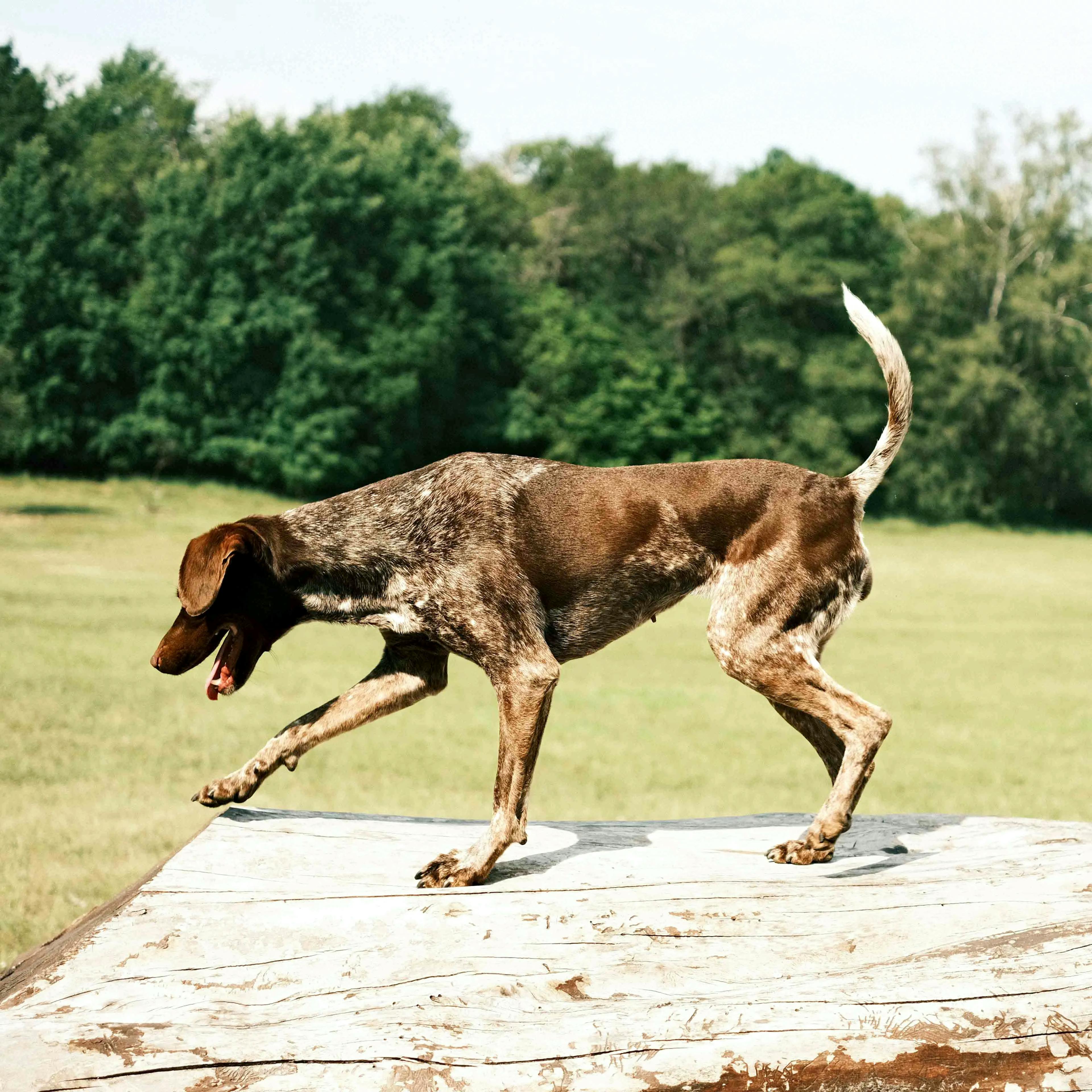
Nutrition for health and energy
We use the larvae of the black soldier fly as the sole animal ingredient in our products, a species that is a real nutritional powerhouse.
The larvae contain plenty of easily digestible protein, crucial for muscle building and performance. They also contain beneficial fatty acids that support skin, coat, and brain function. As if that weren't enough, they are gentle on the stomach and help maintain a balanced gut flora.
This makes them the obvious foundation in all our nutritious and tasty products - and with that, we get sustainability as a bonus!
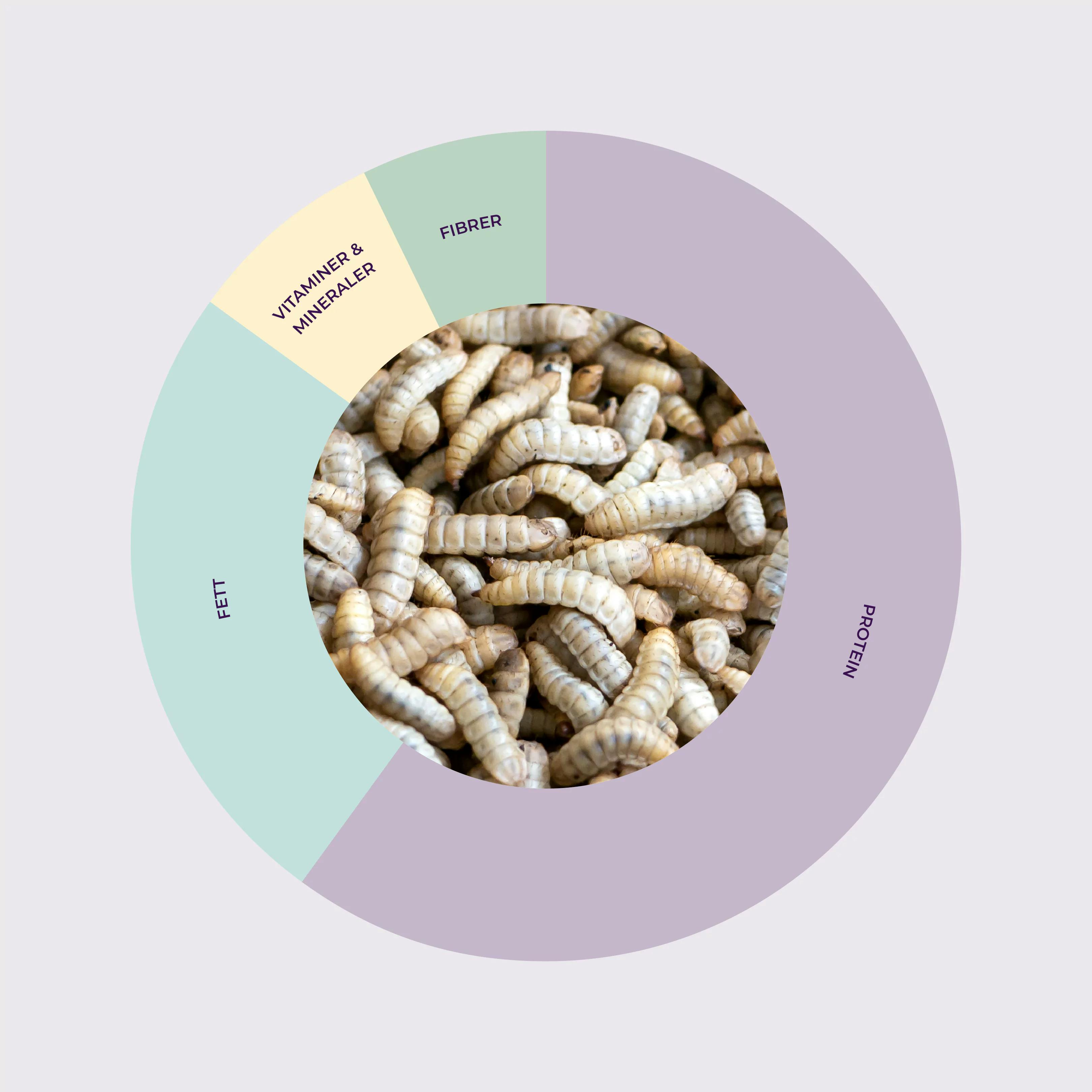
Rich in protein, fat, vitamins & minerals
The larvae we use contain a plethora of nutrients that our dogs and cats need. It's incredibly rich in protein and amino acids, and also contains healthy fats and essential minerals and vitamins.
Thanks to a rich amino acid profile and high digestibility, our insect protein is a high-quality protein source. But what does that mean?
Protein is made up of smaller components called amino acids. Just like humans, dogs, and cats have amino acids that are essential for them, meaning they must get them through their diet. The protein in the larvae is rich in essential amino acids, and our cat and dog foods have complete and balanced amino acid profiles.
It's not just about having enough protein; it's also important that the animal's stomach and intestines can absorb the nutrients. Digestibility is a measure of how much of a nutrient the animal can absorb. The higher the digestibility, the more of the protein the animal's body can take up. Good digestibility is considered to be over 80%. The digestibility of insect protein from the larvae of the black soldier fly is high, ranging from 85-90%.
The fat of our larvae is particularly rich in a fatty acid called lauric acid, which has proven antioxidant activity. Laurie acid belong to a group of fatty acids that have been shown to support brain health and are being evaluated in dogs for their potential to help cognitive function and slow signs of dementia. Our wet food contains plenty of insect fat!
All our complete foods are developed with optimal ratio between omega-3 and omega-6 (1:4.75), to support the skin barrier and quality of the fur.
The larvae are especially rich in calcium, potassium iron and zinc. Calcium gives strength to the bones, Iron is important for the red blood cells capacity to carry oxygen, and zinc supports the immune system and fur quality.
The larvae also contribute with B-vitamins. These group of essential vitamins fill many important function in the body, especially involved in the metabolism and digestive system.
Insect protein is a novel protein source, meaning it can be a suitable choice for a pet with dietary sensitivities. It is also the only animal ingredient we use in our products.
The larvae's content of dietary fibers contributes to normal bowel movements and nourishment to the gut flora. Recent research also demonstrates the potential of the black soldier fly larvae to positively modulate the gut microbiome - and increase the presence of good gut bacteria!
We at Petgood and our insect farm Protix specialize in the larvae of the black soldier fly for pet food, and have close research collaborations with leading European universities to drive knowledge forward.
There are many published studies evaluating the nutritional content of the black soldier fly larvae and its suitability as dog and cat food, focusing on various aspects such as amino acid profile, digestibility, fatty acids, and gut health.
Click here to delve into the research behind insect protein and find references!
We always follow the latest scientific findings regarding nutritional recommendations when developing our recipes, and all our products are formulated by our own veterinary team along with small animal nutritionists to ensure an optimal nutritional profile and promote health.
All our feeds are complete and balanced, meaning they meet all the nutritional needs of dogs or cats. We adhere to FEDIAF's and NRC's nutritional recommendations.

How does insect farming work?
One of the most common questions we get is what kind of insect we use in our products. This is a question we love to receive - we are proud of our insects. They are the ones who are the true climate heroes and also the reason why Petgood was founded.
We exclusively use the larva of the black soldier fly (Hermetia illucens) as an animal ingredient in our products - given all the health and sustainability benefits, we see no reason to use any other animal ingredients.
Our insects come from one of the world's leading insect farms, Protix, located in the Netherlands. Our partner has extensive experience in insect farming and has been chosen based on its high product quality and animal welfare standards. With a location in the EU, we can ensure maximum transparency and quality control in production. Protix is powered by 100% renewable energy, from solar and wind power.
The insects eat high-quality plant by-products; a mix of grain, fruit and vegetable scraps from local producers. An example is potato peels from a French fries manufacturer. In this way, they make use of resources that already exist, and we avoid food waste!
Our larvae live in a vertical farming system, in a nesting material similar to what they would have chosen in nature. They have the opportunity to burrow, to ensure their ability to express their natural behavior.
The insect farm uses sensory technology, which ensures that the insects' environment is kept ideal for them: perfect humidity and temperature - they like to be warm!
No. At our insect farm, antibiotics are never used. Our larvae are naturally resistant to diseases and grow rapidly on their own in an environment that provides the best conditions for them to be healthy, so it simply isn't necessary.
It is important for us that the insects are well taken care of when they are alive, and also allowed to end their lives as painlessly as possible. When the larvae are fully grown, they are cooled down, which puts them into a natural dormant state, which means that the risk of suffering is minimised. They are then ground down to the protein-rich meal that forms the basis of our dog food and other products.
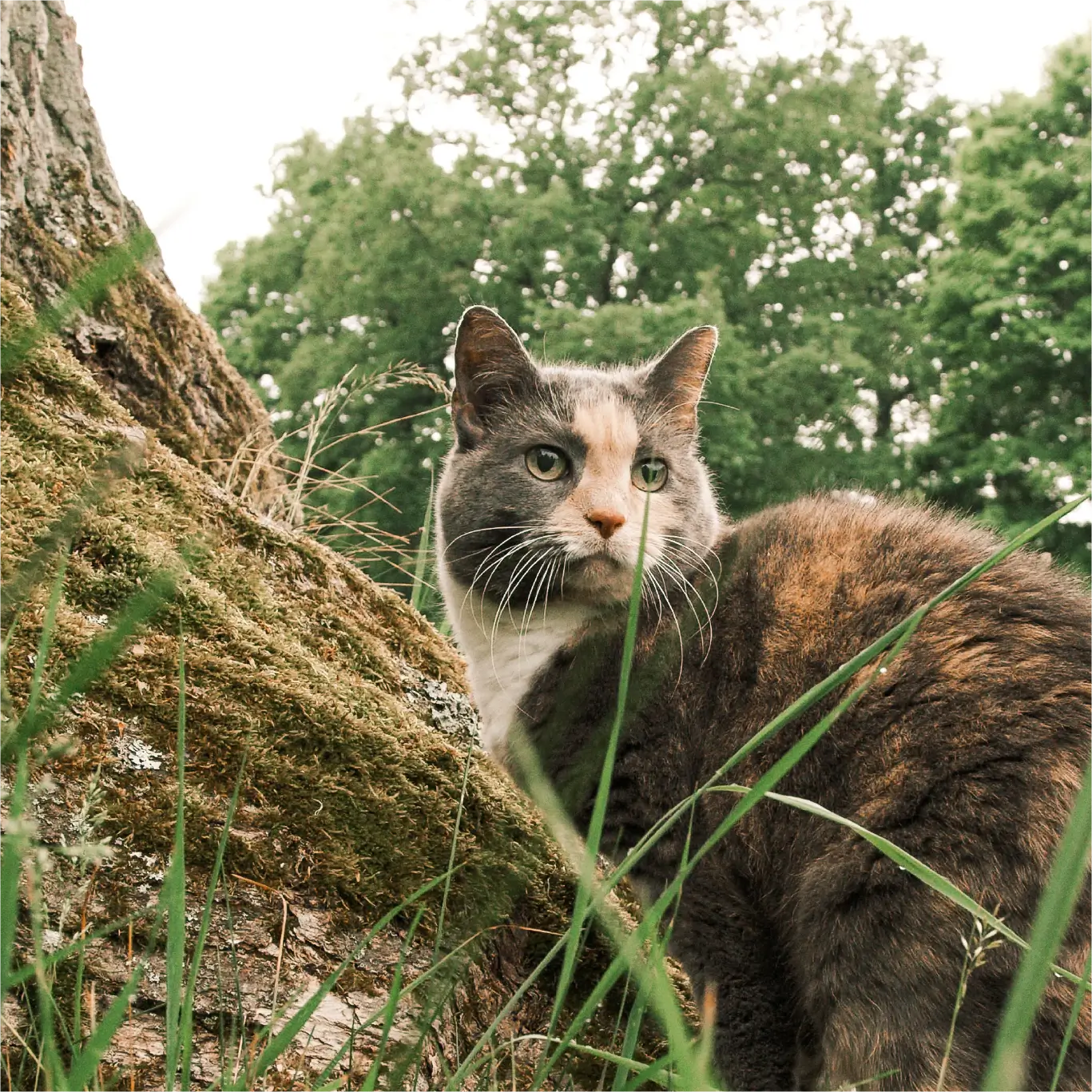
Sustainability as a bonus
Today, dogs and cats account for 25% of all meat consumption. Production of animal protein sources has a major impact on the planet. Insects are an extremely resource-efficient protein source compared to other animal protein sources. We tell you more about why this is important below.
It is not always easy to know where the protein source in dog and cat food comes from. Most often it concerns meat or fish, where it can be difficult to know what type of meat is used, where it comes from or how the animals have been treated. We are open with our supplier - the insect farm Protix in the Netherlands. In this way, we can ensure that our protein is always sustainable and maintains the same high quality. All our plant-based ingredients are also traceable and come from the EU.
The production of protein from traditional sources such as beef, chicken and pork today accounts for large carbon dioxide emissions. The research is clear; reduced meat consumption is a key factor in reducing our climate footprint. A new study from Finland also states that replacing traditional protein sources with insects can reduce our environmental impact by 80%.
Large areas of land are required to raise livestock and meat-producing animals. More than 80% of today's agricultural land is currently used for meat and milk production. Increased spread of humans and our animal husbandry threatens important ecosystems on both land and water. Did you know that of all the mammals in the world, wild animals today account for only 4%, and much of this is due to the fact that their natural habitats no longer exist?
20 tons of insects can be raised on the surface of a tennis court, and our insect farm can produce 10,000 tons of protein on one hectare in a year! If we start to use our resources more wisely, we can spare more land for wilderness and vital ecosystems.
Large areas around the world are used to grow feed which in turn is used for livestock, which in turn is used for food... This is an unnecessary detour and a waste of precious resources. In Sweden, two-thirds of the grain that is grown is used for food-producing animals, grain that could instead have been used directly for human consumption. Over 95% of the soy we import into Europe is used as feed for meat-producing animals, and it has often been grown on cleared rainforest land, further contributing to the destruction of natural habitats.
By ceasing meat and dairy production, agricultural land could be reduced by more than 75 percent, an area the size of the United States, China, the EU and Australia combined - and still manage to feed the world's population.
Our insects live only on plant-based food scraps – our insect farm collaborates with local companies and producers, and makes use of food waste. The larvae then efficiently convert the food waste and by-products into high-quality protein, making production circular and very resource-efficient.
Another important factor for many consumers is animal welfare in the meat industry. From an ethical perspective, there are several aspects to take into account, but if we look at the dog food industry as a whole, the lower traceability makes it more difficult for the consumer to know how the animals lived and were handled. Depending on which country the meat comes from, there are different standards for animal welfare and slaughter, and whether antibiotics or growth hormones are used. Antibiotic resistance is today one of the biggest threats to our public health.
During the breeding of our insects, antibiotics or growth hormones are never used, because insects thrive and grow quickly all on their own. The insects are kept in a habitat that mimics their natural, and when it is time to harvest the larvae, this is done by cooling them down so that they go into a natural dormancy and are not aware of further steps. This means that it can feel like an ethically better alternative as a protein source for your dog or cat, for you who yourself have chosen to exclude meat from your diet.


